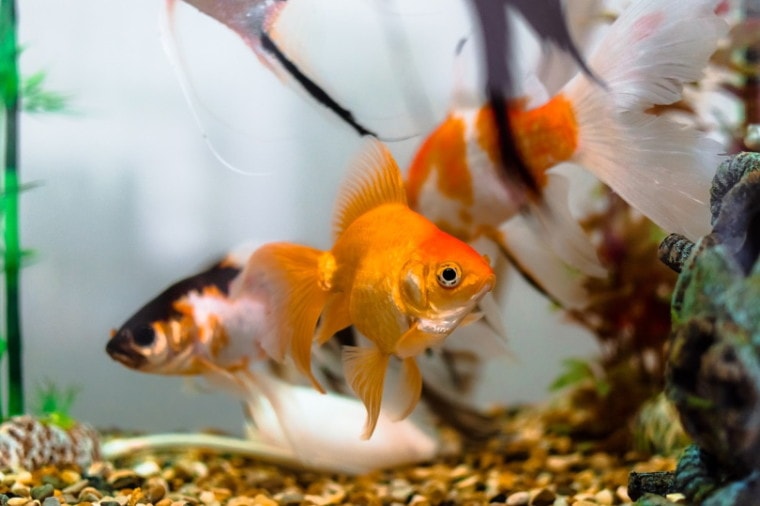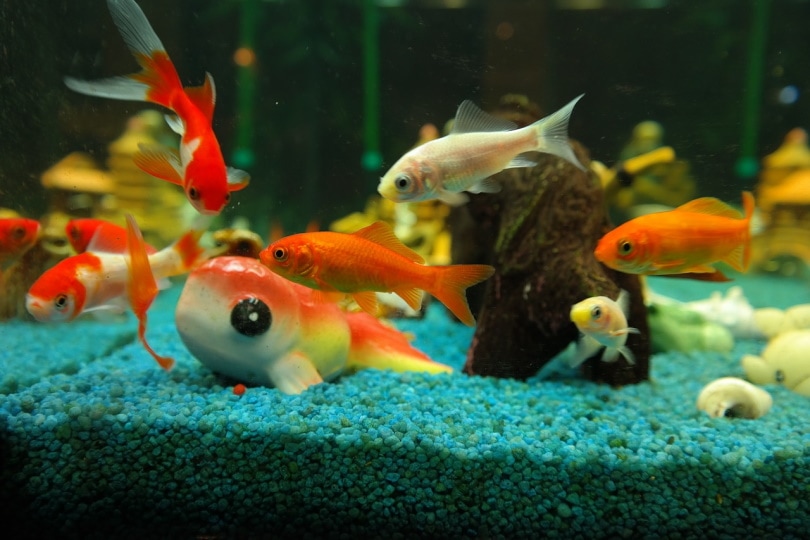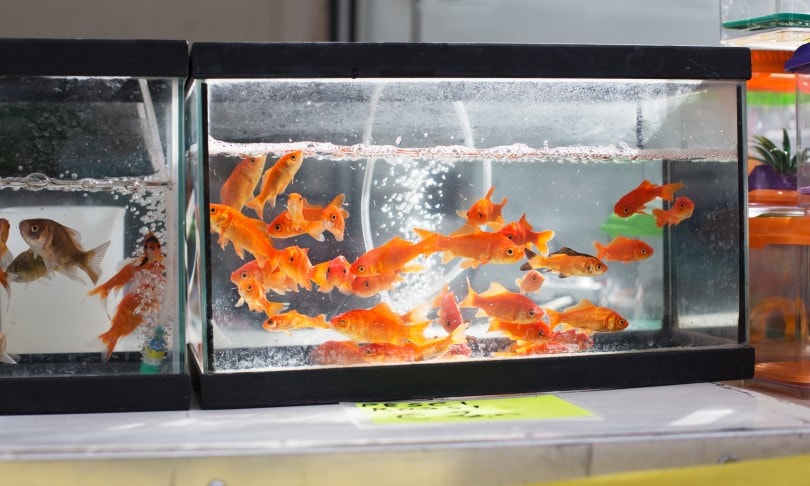
If you run in any goldfish keeping circles, then you’ve definitely heard people say that goldfish are cold-water fish and shouldn’t be kept in heated tanks. You’ve probably also encountered people who insisted that goldfish should only be kept in heated tanks since room temperature water can feel cold to the touch. And then, of course, there are the people you encounter who insist that the temperature your goldfish are kept at doesn’t matter, but they should only be kept in ponds and not indoor tanks.
With all these differing opinions and information sources, it can be confusing to know what’s best. The ideal temperature for goldfish, whether they’re kept indoors or outdoors is 16-22°C (60.8-71.6°F). Fancy goldfish have lower tolerances to changes in temperature and should be kept at 20-23°C (68-74°F). When it comes to temperature ranges for goldfish, there is some fact and some fiction. We’re here to help clear all of it up.
Tank or Pond?

When it comes to where you keep your goldfish, there really isn’t a science to it. If you live in an area where water temperatures rarely exceed 50-60˚F (10-15.5˚C), then your goldfish would need a heated pond or an indoor home. If you live in a tropical area with no shade, then your goldfish would likely need an indoor environment to ensure their water doesn’t get too hot during the hottest, sunniest parts of the day. Alternatively, you would have to invest in a water chiller system to ensure that the water in your pond doesn’t get too warm.
You really have to use your best judgement when choosing whether you’ll keep your goldfish indoors or outdoors. Some people even have a pond for part of the year and a tank for the other part of the year. That is all up to you and how well you feel you will be able to manage water temperatures either indoors or outdoors. Keep in mind, though, that water heaters are far more accessible and affordable than water cooling systems, so it’s usually best to err on the side of the cooler environment.
You might also be interested in: 6 Best Automatic Pond Fish Feeders
What Is the Ideal Pond Temperature Range?

The general recommendation for a healthy temperature range for goldfish is 68-74˚F (20-23.3˚C). However, common-type goldfish can thrive in water as cool as 62˚F (16.7˚C) or so, and usually do best in water that is 72˚F (22.2˚C) or below. Fancy goldfish cannot tolerate the same cool temperatures that common goldfish can, so they usually prefer 68˚F (20˚C) as the temperature minimum, but are often happiest in water from 70-76˚F (21-24.4˚C). Some people even feel their fancy goldfish are comfortable and happy in water as warm as 80˚F (26.7˚C).
Here’s the thing about keeping goldfish in ponds, though. Outdoor environments allow them to experience the temperature changes they would experience in nature. This means that breeding is naturally stimulated by the changing of the seasons, and in cold weather, goldfish will enter a state of torpor. If you’re concerned about your goldfish getting too cold during the winter, you should know that common-type goldfish can tolerate water as cold as 32-40˚F (0-4.4˚C). The key to cold temperatures is preventing the water from freezing completely over to ensure oxygen continues to enter the water. This can accomplished by ensuring your pond is deep enough to not freeze entirely during the winter, goldfish won’t survive if they’re frozen solid.
What Is Torpor?

Torpor is a state of semi-hibernation. It’s not true hibernation because the fish are still awake and active part of the time, but while in torpor, they are in a state of significantly reduced metabolic activity. This means they eat less and move less. Torpor is a part of the natural life cycle of goldfish, and in the wild, goldfish will leave the torpor state as water temperatures warm. This warming of the water stimulates spawning, which is why one of the tricks some people use to stimulate spawning in the home aquarium is to raise the water temperature a few degrees.
Torpor is not a necessary function for long-term survival. It is a natural adaptation that allows wild goldfish to survive the winter when food is scarce and water temperatures plummet. Domestic, pet goldfish don’t necessarily need to enter a state of torpor to live long, happy lives.
What Is the Ideal Tank Temperature Range?

In the home aquarium, the temperature ranges for common and fancy goldfish are the same as they are for a pond. The difference is that you have a greater amount of control over the water temperature indoors. Indoor heating and air, as well as water heaters, allow you to monitor and adjust the temperature within a couple of degrees.
If you are looking for help to get the water quality just right for your goldfish family in their aquarium, or just want to learn more about goldfish water quality (and more!), we recommend you check out the best-selling book, The Truth About Goldfish, on Amazon today. It covers everything from water conditioners to tank maintenance, and it also gives you full, hard copy access to their essential fishkeeping medicine cabinet!
This is the ideal environment for fancy goldfish since they are less tolerant of temperature swings than common goldfish are. Some fancy goldfish do well in ponds, especially ponds in areas with stable temperatures. To maintain the temperature range preferred by fancy goldfish, you may need a heater for your tank. However, it’s a good idea to monitor your tank temperature throughout the day while you are cycling your tank. This will allow you to get an idea of how the temperature changes based on the time of day, sunlight in the room, and whether your heating or air conditioning are running.
What’s Even More Important Than the Temperature Itself?

Acclimation is far more important to your goldfish than the water temperature itself. Temperature extremes can be dangerous, but goldfish tolerate a wide temperature range if they are properly acclimated. Goldfish that are in a pond will experience slow temperature changes based on the time of day and the season. Goldfish in a tank will typically experience relatively stable temperatures.
Here’s where acclimation comes into play. If you’re performing a water change and your current tank water is 70˚F (21˚C), but the water you refill the tank with came straight from your hot water tap, then the rapid change in the water temperature can lead to shock. The necessity of acclimation is the main reason you float your new fish before introducing them to your tank. Otherwise, they can be shocked by sudden temperature changes between the bag and the tank.
Any temperature changes in your tank should be done slowly to prevent shock. If you need to turn the heater up to help treat Ich disease, you need to do so slowly. Generally, you’ll only raise the temperature 1-2˚ every 12-24 hours until you reach the desired temperature. Always aim for slow temperature changes. Even the hardiest goldfish are susceptible to shock from improper temperature acclimation.
Summary
Goldfish can happily and safely live in ponds or tanks but monitoring water temperatures is important to ensuring the water stays at levels that are comfortable for your goldfish. Goldfish kept at warmer temperatures tend to grow faster, which can potentially shorten their lifespan by increasing their metabolism. Goldfish are naturally cold-water fish, but they are also hardy fish that are comfortable in a wide range of environments.
Featured Image Credit: Pexels, Pixabay










